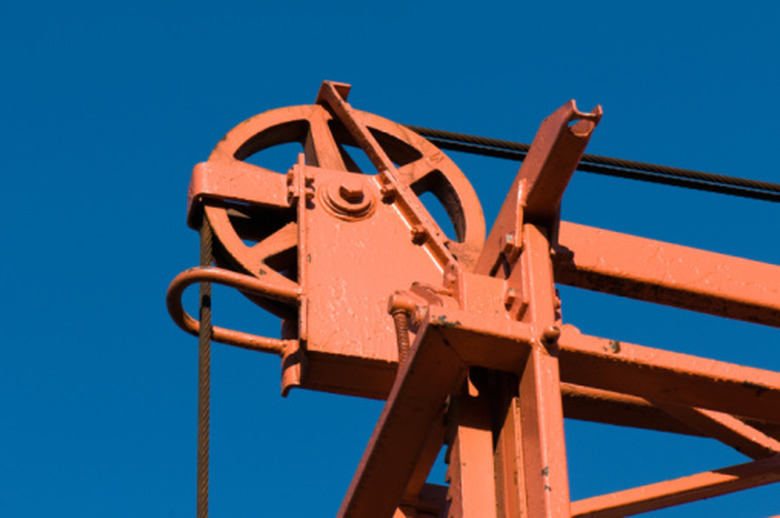Principles Of Pulleys & Levers
Both pulleys and levers have been utilized for centuries as a means of accomplishing heavy tasks. These simple machines utilize the laws of physics to efficiently move weight over a distance. They allow a single person to move weights that a human would be incapable of lifting without the intervention of such tools.
Multiple-Wheel Pulleys
Multiple-Wheel Pulleys
If you feed a rope over the top of a single pulley and lift a weight with it, you will be pulling the rope the same distance as the weight is lifted, and effectively lifting the same weight. However, if you attach the rope to the bottom of the pulley's frame, run it through another pulley and back up through the first, you will then be pulling the rope twice the distance that the weight is lifted, but lifting only half of the weight. The practical result of this is that you could lift, for example, a 100-pound weight 10 feet by pulling a rope 20 feet with what feels like a weight of 50 pounds on it. This principle can be extended indefinitely by adding more pulleys.
Geared Pulleys
Geared Pulleys
The ratio of weight to distance can also be modified by using pulleys with different diameters.This is essentially the same principle as the familiar operation of bicycle gears. When you turn a gear with a large diameter that is attached by a chain to a gear with a small diameter, the smaller gear will rotate more rapidly. By attaching pulleys of different diameters to one another with ropes or chains, you can greatly extend your lifting power by simply pulling the rope or chain for a longer distance than the weight is lifted.
Levers
Levers
A lever operates under the same principle as a pulley, but in a very different physical manner. If you take a 10-foot board and rest it on a fulcrum at its center, you can place a weight on one end and lift it by pressing down on the other end. The distance you lower one end will be identical to the distance that the other end lifts and will require the same amount of weight. However, if you offset the fulcrum from the center of the board — the lever — you gain a mechanical advantage. If the fulcrum is one foot from one end and nine feet from the other end, you can lift a very heavy weight by simply lowering the long end nine times farther than the shorter end rises.
The Legacy of Pulleys and Levers
The Legacy of Pulleys and Levers
Pulleys and levers and the physics that underlie them are the basis for many modern machines. Everything from water wheels to internal combustion engines utilize the principle of transforming weight into distance.
Cite This Article
MLA
Xaxx, Jagg. "Principles Of Pulleys & Levers" sciencing.com, https://www.sciencing.com/principles-pulleys-levers-8034828/. 24 April 2017.
APA
Xaxx, Jagg. (2017, April 24). Principles Of Pulleys & Levers. sciencing.com. Retrieved from https://www.sciencing.com/principles-pulleys-levers-8034828/
Chicago
Xaxx, Jagg. Principles Of Pulleys & Levers last modified August 30, 2022. https://www.sciencing.com/principles-pulleys-levers-8034828/
